Spey Fishing For Great Lakes Steelhead: Guide Tactics
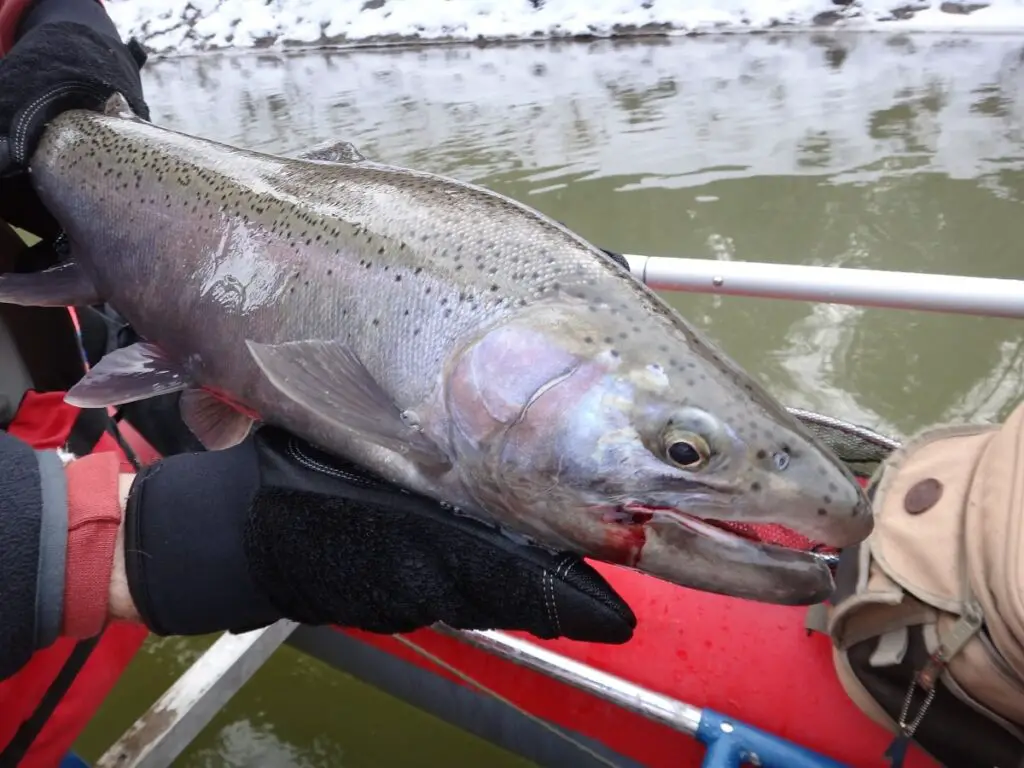
I have a unique perspective on catching steelhead since I am very well-versed in many fishing methods. Using special tactics for Spey fishing for Great Lakes steelhead, I seem to consistently catch double, triple, or even ten times more steelhead than most anglers swinging flies.
Most anglers do Spey fish for steelhead the same. They cast a Spey fly across the river with a Spey rod and Spey line, allow it to swing across the river, step down three feet, and then repeat. I do something very different, and I’ve yet to see another steelhead guide or angler fish the way I swing flies for steelhead, but I tend to catch a lot more steelhead.
The keys to success when swinging for steelhead are:
- Location: I fish where the steelhead are holding, and I focus on the most suitable water for swinging flies. This includes most water from two to ten feet deep with moderate current speed.
- The Fly Pattern: Use proven Spey flies that trigger a strike response in the steelhead. There are a few very good flies that do this.
- Fly Depth: Learn my specialized flies and sink tips to get my fly down to the steelheads strike zone.
- Fly Speed: I use mending to slow my fly speed, speed up the fly, or change the fly angle to trigger more bites. I use different speeds and angles at different times.
10X More Steelhead: I will cover all of this in detail below and provide a unique and advanced method I use to catch up to ten times more steelhead.
Gear: You will also need the proper setup to ensure you are fishing effectively. The proper setup includes the right fly line, the right-sized sink tips, the proper-sized tippet, and the right flies.
Is Spey Fishing For Great Lakes Steelhead Effective?
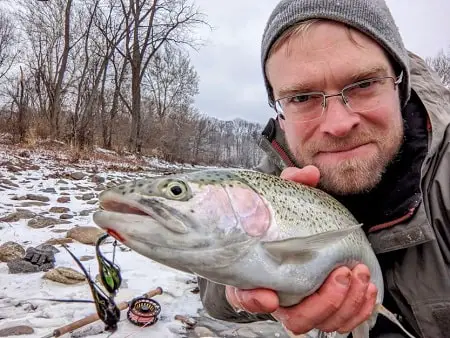
Fishing for steelhead with a Spey rod can be very effective on most Great Lakes rivers if you know what you are doing.
Swinging flies attracts only the most aggressive steelhead because these are the ones willing to chase a moving target. I believe that most days, less than 25 percent of the steelhead in the river will be this aggressive.
I think anglers catch fewer fish because they don’t swing their flies effectively. They simply don’t understand how to get the flies deep enough or how or when to speed them up or slow them down to rigger more bites. I will discuss these in more detail below.
Great Lakes Spey Rivers
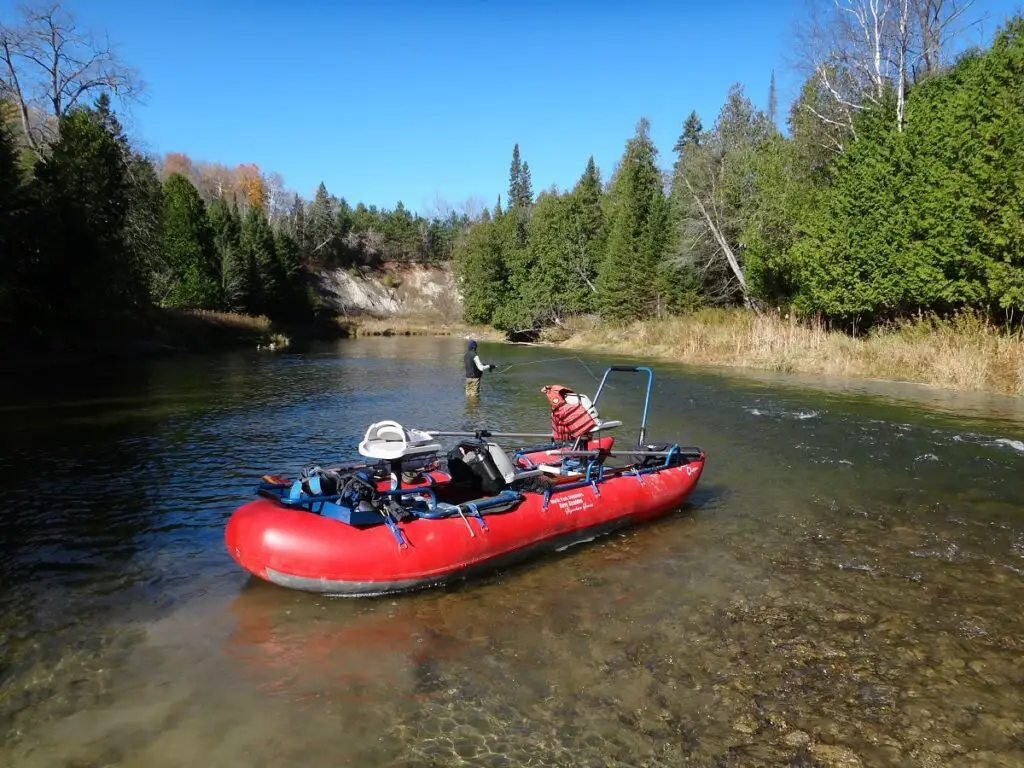
Not all rivers are great for swinging flies for steelhead, and anglers will have their challenges with this method, but with the right rods, reels, lines, and flies, anglers can experience multiple hook-ups in a day.
Most Great Lakes Spey rivers are on the smaller side averaging 30 to 60 feet wide, but they are definitely fishable with a Spey rod.
Best Spey Rods For Great Lakes Steelhead
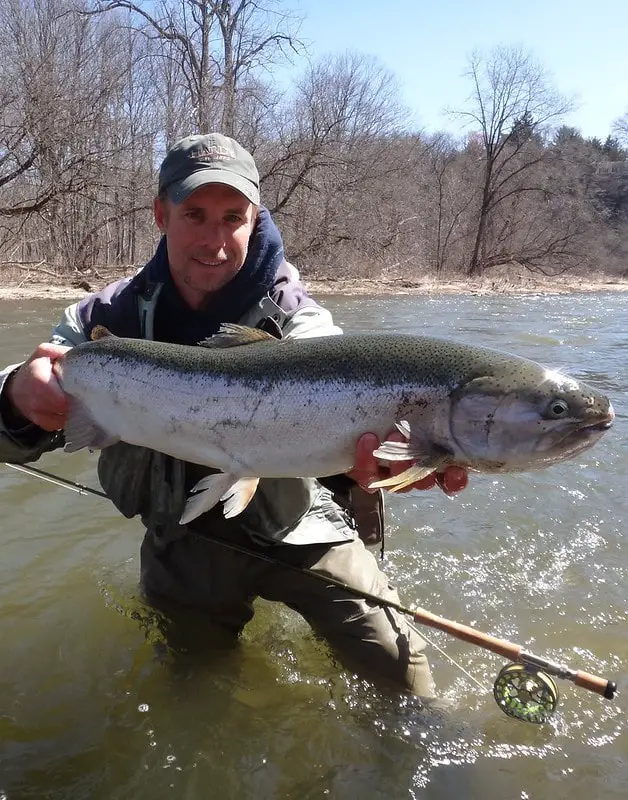
My preferred size Spey rod for fishing most Great Lakes steelhead rivers is a 12-foot to 13’6, 7-weight Spey rod.
Some good Spey rods to consider are:
- Redington Claymore Spey Fly Rod: Best All Around Spey Rod $450.00
- G. Loomis Asquith Spey Rod: Best High-End Spey Rod
- Orvis Clearwater Spey Rod: Good Beginner Rod
I go into more detail and show you some of the best rods on my page, Best Spey Rods For Steelhead.
Another type of rod that I have used and guided with and is also popular is the switch rod.
Switch rods are designed to be used with spey lines, but they can also be used to nymph fish with indicators. They are what I would call a hybrid system.
My first switch rod was fun and inexpensive, and I could easily Spey cast 80 feet of line with a heavy Skagit Spey line, a heavy sink tip, and large flies like intruders.
If this sounds like the rod type for you, check out my article Best Switch Rods For Steelhead.
Spey Reels
When it comes to Spey reels and switch rod reels, I’m going to risk saying that any fly reel with an enclosed drag, and a size that matches or balances the Spey rod will be fine.
The general rule of thumb is your fly reel should be two sizes bigger than the fly rod rating. This will allow for the thicker spey lines and the extra fly line backing.
While there are some expert and die-hard Spey guys who like click-and-pawl type fly reels (reels with no drag), I highly recommend a fly reel with a good smooth drag system. Based on my experience, most anglers will land a lot more fish with a smooth drag system.
Good Spey reel options are:
- Redington Behemoth Fly Reel
- Orvis Hydros Fly Reel
- Lamson Liquid Fly Reel
- Redington Grande Fly Reel
Check out my switch reel and spey reel reviews.
Spey Lines
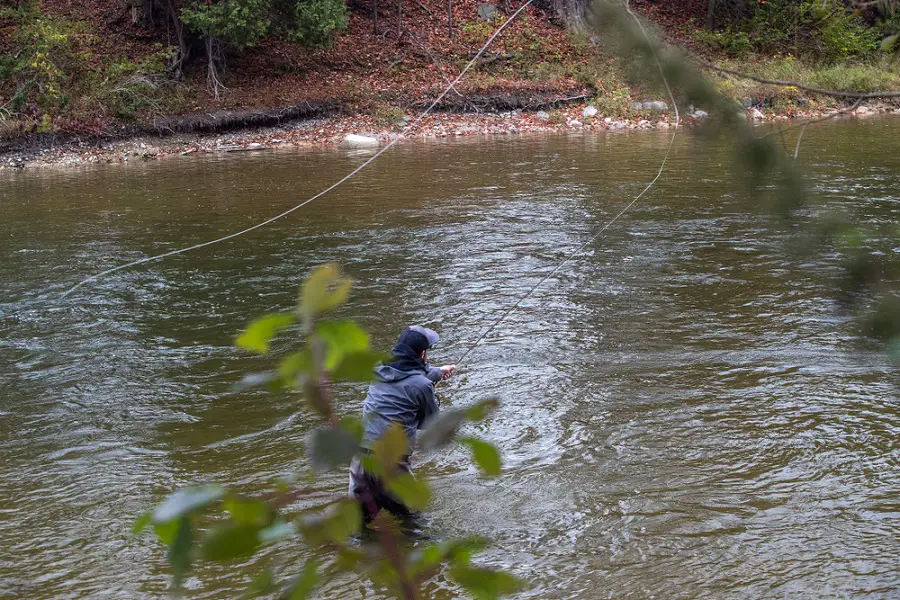
Skagit Lines – Very Good: The best Spey fly line for steelhead on Great Lakes rivers that are narrow and deeper is a Skagit fly line or Skagit heads. Skagit lines are heavy, and they allow anglers to throw heavy sinking tips a long way with ease. Skagit lines are best in water from 3 to 12 feet deep.
These Skagit shooting-head lines are the preferred choice for most anglers due to their ease in casting large flies and heavy sink tips. The length of these heads can vary from 11 to 29 feet, contingent on the specific line. They’re engineered to pair with a running line system, along with either a sinking or floating tip.
Tips like Mow Tips, or Poly Leaders are usually sold as standalone items.
Anglers focusing on steelhead tend to lean towards notably mid-length to longer shooting heads, while those in pursuit of trout prefer short heads.
I have found that Skagit lines are the easiest for new anglers to learn to cast and are my preferred line to use when I am guiding.
Skagit Lines I Use and Recommend:
- Rio InTouch Short Head Spey Fly Line
- RIO Skagit Launch heads
- OPST Commando
Scandi Lines – Good: Scandi Spey lines are another good option on wider and shallower rivers that don’t require a heavy sink tip to get the fly down fast. The Scandi Spey lines are good for fishing in water that is less than 5 feet deep. Some anglers prefer Scandi lines.
Good Scandi lines include:
- Rio InTouch Mid-Head Spey Line
Traditional Spey Lines – Not Recommended: Traditional Spey lines are the least used lines. However, they can be good when fishing shallow water with lighter flies, but it’s not often the steelhead will be holding and feeding in shallow water.
A good traditional Spey line is the Rio InTouch Long Head Spey Line.
I discuss the Spey lines in detail and list my favorites on my page, Exploring the World of Spey Fly Fishing Lines.
Sink Tips For Steelhead
Sink tips are a section added to the end of the Spey or fly lines for the purpose of sinking the end of the fly line and the fly.
The heavier and longer the tip, the faster and deeper the fly will sink.
Sink Tip Length: To get the desired depth, I use a 9 to 15-foot sink tip line. This sink tip length should be good for most rods between 11 and 14 feet long, and I change my tip length based on the type of water I’m fishing.
Perfect Length: For most mid-sized great lakes rivers that are 30 to 60 feet wide, I like to use sink tips between 10 and 12 feet long with a three to five-foot tippet.
Types Of Sink Tips: Because of the way the Great Lakes rivers are, with a combination of long deep pools, some shallower runs, and pockets with boulders, I prefer to use RIO MOW tips to help me get my flies into tight spots and pockets.
Medium-Sized Rivers – T-9 To T-11 Sink Tips: For most mid-sized rivers of 30 to 60 feet wide, I find that a T-9 to a T-11 sink tip will work just fine.
Large, Deep, and Fast Srivers – T-14 Sink Tips: On larger rivers over 60 feet wide with medium to fast currents, a T-14 might be a better option. However, I prefer to use a proper mending technique with a T-11 to get my fly into the strike zone most of the time.
Sink Tip Color: If possible, I prefer sink tips in darker colors like green, grey, or black. I avoid lighter-colored sink tips in tans, yellows, or whites.
I get into more detail and list the best sink tips on my page, Sink Tips for Spey Fishing and Switch Rods.
Tippets
Tippet / Leader Length: When steelhead fishing in most types of water, I will mostly use a 3 to 5-foot fluorocarbon leader attached to the end of the sink tip.
Dirty Water Tippet / Leader Length: In dirtier water or when needing to get my fly deep quickly behind a boulder or in a pocket, I want my fly closer to the sink tip so I might drop down to a two or three-foot tippet.
Clear and Shallow Water Tippet Length: When fishing very clear water or a section of the river shallower than four feet, I want my fly further from my sink tip so the steelhead do not see the sink tip and so the fly will ride higher. Therefore, I will run a five-foot tippet.
Tippet / Leader Strength: My go-to leader strength is 1X or 0X. (12 pounds to 15 pounds)
Best Spey Flies For Great Lakes Steelhead
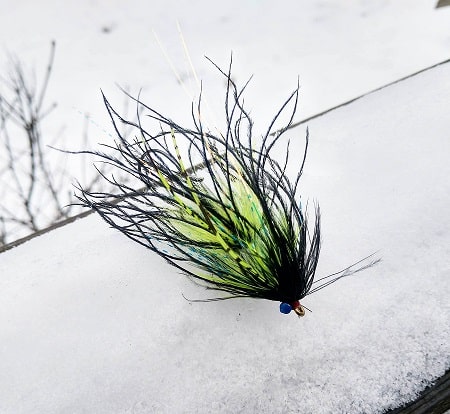
I always carry a variety of flies in different sizes to accommodate varying sinking speeds. Thicker or bulkier flies tend to sink slower, while thinner flies sink faster.
Typically, my average-sized fly measures around three inches long.
I’ve discovered that certain colors work better in specific river conditions or water clarities. Therefore, having a small assortment of fly colors in your box is wise.
Here are some of the most effective flies I’ve found for Great Lakes steelhead:
- The Hobo Spey: This fly was recommended to me by a local guide. It’s a simplified version of the Intruder Spey Fly, making it easier and quicker to tie. Despite its simplicity, it proves highly effective for steelhead fishing around the Great Lakes. I tie this fly in Olive, Black, White, Yellow, and multi-color variations.
- The Intruder Spey Fly: Originally designed for West Coast steelhead fishing, this larger and bulkier fly has shown great success in Great Lakes steelhead fishing as well. Although it requires more time to tie, many anglers and guides swear by its effectiveness. I tie it in Olive, Black, White, Yellow, and multicolor.
- Woolly Bugger Spey Fly: This basic Woolly Bugger fly may not be popular among traditional Spey enthusiasts, but its simplicity and effectiveness cannot be denied. In fact, I’ve found it to be as successful as the beloved Intruder Spey fly, if not more so at times. Its superior sinking ability compared to bulkier flies contributes to its effectiveness. I enhance the fly by adding extra bulk to the tail with additional marabou and incorporating tinsel or other flashy materials. I tie Woolly Buggers in Olive, Black, White, Yellow, Chartreuse, Orange, and multicolor variations.
- Egg Sucking Leech: Although this fly may not be favored by die-hard Spey anglers, its effectiveness is undeniable. It’s readily available for purchase, easy to tie, and replaceable if lost. Typically, the fly features black or olive body colors with bright heads. I personally prefer chartreuse, pink, orange, and red head.
- Bunny Leech Fly: Originally a trout fly, the Bunny Leech has proven itself effective for steelhead as well. Unlike many other Spey flies, it’s the pulsating movement created by the rabbit fur that truly attracts steelhead. You can tie this fly to different lengths using magnum rabbit strips or keep it shorter. I use Olive, Black, White, Yellow, and multicolor variations for this fly.
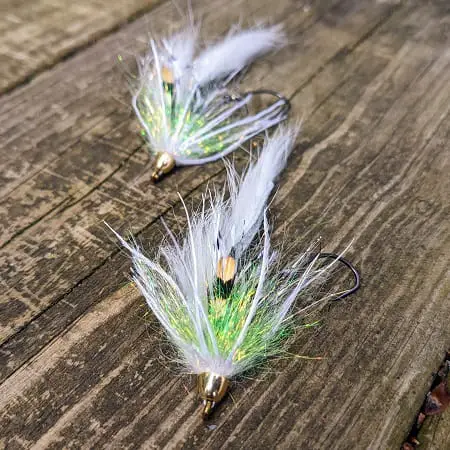
While many spey flies are being recommended, I’ve tried almost all of them with little success.
The flies I recommend are proven effective for Great Lakes steelhead fishing, but there are some more great flies in my article Best Spey Flies For Great Lakes Steelhead and Salmon.
Mending And Fly Speed Explained
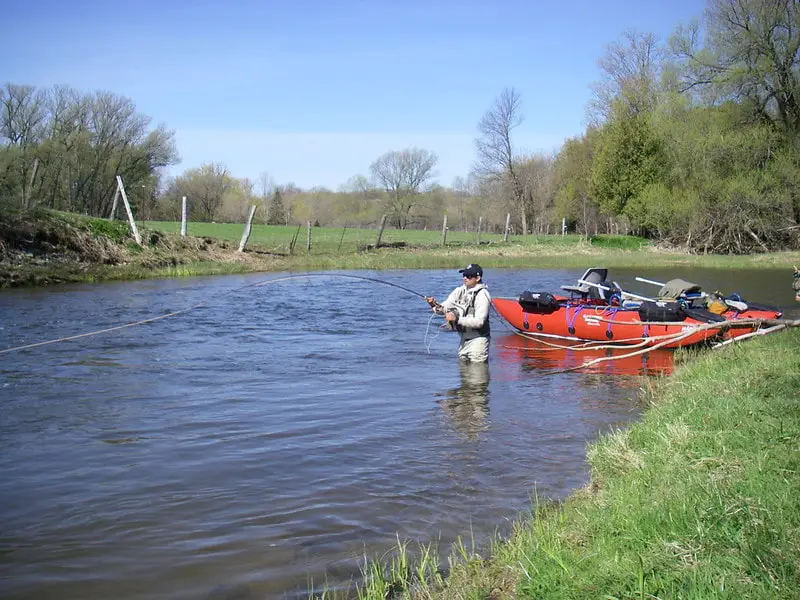
One of the things I teach my clients is to control the fly speed and angles when swinging flies for steelhead.
I think it’s even more critical to control the speed of the fly and slow it down during the winter months when the steelhead can be the least aggressive.
It is possible to slow down or speed up your fly.
To control my speed and the angle of the fly, I mend my line after each cast and then control the line angle and the speed of the fly throughout the entire drift.
At times, the steelhead won’t care about fly speed, but as a guide, I always experiment with speed to determine if they prefer a slower or faster fly.
Slower and Deeper Fly Presentation: After my fly lands as far across as I can get it, I do a hard mend upriver with the entire line and sink tip.
This creates some slack in the line, slows the pull from the current, which takes the tension off the fly allowing the fly to sink deeper before it starts to swing.
Periodic mending of the fly line upriver will keep the fly line angle more upriver, which makes the fly swing slower and changes the angle of the fly so it’s facing more upriver.
This works for a deeper fly and will slow your fly down, which is often necessary for cold water and less aggressive steelhead.
Faster Fly Presentation: Doing no mend at all, or using a downward mend when your fly lands will create quicker drag on the line, which will pull your fly faster. This keeps your fly riding higher in the water column, it changes the angle of the fly so it faces more sideways towards your bank, and it increases the speed of the fly.
At times, with aggressive steelhead, this is what they want. A faster fly swing allows you to cover more water faster.
I will often use both slow and fast presentations throughout the day and in different spots to determine what the steelhead prefers. If I determine one or the other is working best, I’ll stick with that speed.
Deep and Fast Presentation: Throwing a hard upward mend in the line as soon as it lands will sink the fly deeper, once the fly starts to swing, downriver or side mend towards your bank with speed up the fly.
This gives me a deeper fly that moves sideways and moves faster. This is my ideal method and presentation most times when the steelhead are agressive.
Getting Your Flies Even Deeper Down
Part of mending is to help your fly sink. To get your fly deep enough, you need to use sink tips combined with mending.
I want my fly to be within three feet of the bottom of the river during spring and fall, and slightly deeper in the winter.
I choose a tip based on the speed and depth of the area I want to target. I can also increase the sink rate with proper upward mends.
My Advanced Method To Catch Ten Times More Steelhead
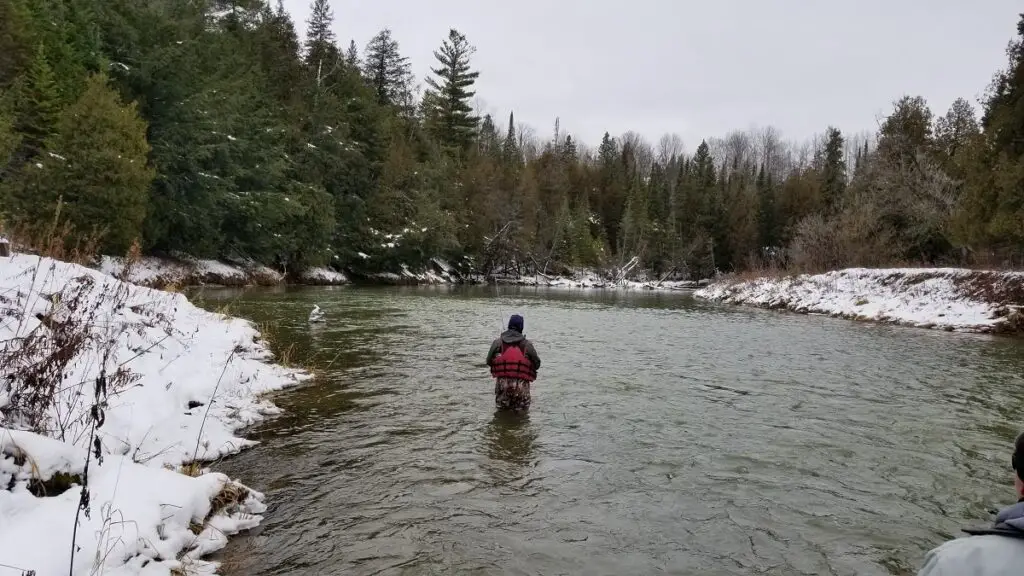
When I first started using a spey rod, one of my questions was, “How do I know my fly is deep enough?”
I asked a bunch of my buddies and some of my very excellent Spey guide friends, and the typical response was, “Guess the depth and the sink tip size you need, and then try to bump the bottom. When you do bump bottom, change your sink tip to a lighter tip so the fly is one to three feet off the bottom.”
So I did this for a season, but I hated constantly changing my sink tips, and I knew from nymphing and float fishing that the river bed from the top of the pool to the bottom of the pool or from the close bank to the far bank is rarely the same depth. This meant changing sink tips multiple times in some pools or fishing too high or too deep.
I also knew that I caught a lot of my fish in deeper holes or trenches that I could find when dragging nymphs or baits through the pool, but I was not confident my swung fly was getting into these spots.
I never really had confidence with this standard method of swinging flies and changing sink tips. So I started doing something I’d never heard of or seen before, and it paid off HUGE!

This is a three-step method used to get more depth or find fish.
Many days I have stepped off the water after hooked 5 to 10 steelhead when every other spey angler I talked to is hooking 0 to 3.
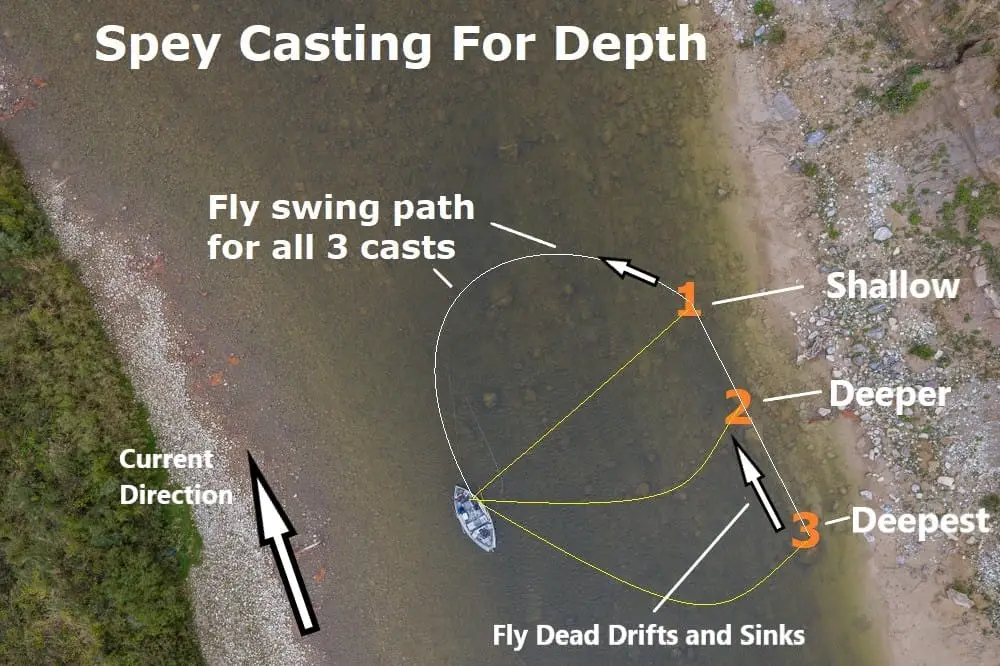
Cast #1 – The fly lands slighty downriver of the angler and starts swinging immediately, keeping the fly higher in the water column.
Cast #2 – The second cast is straight across the river or slightly upriver of the angler. I mend upriver so the fly will dead drift down to position#1. It will sink deeper on the dead drift and will start to swing at the same spot as cast #1. This can get the fly 2 to 4 feet deeper than cast position #1.
Cast #3 – Cast position #3 is 15 to 30 feet upriver of the angler. I throw a hard upriver mend, which gives the fly even more time to sink before it starts to swing in the same spot as cast position #1.
With each cast, I am either hoping to hook a fish, or to bump the bottom.
If I hit bottom on any of these casts, I will not make another cast upriver and will likely aim for the previous position on the next cast. Meaning if I hit bottom on cast #3, when I step down three feet, I will cast position #2 and skip position #1.
If I hit a fish, I know I’m in the strike zone, so I will keep fishing that position on future casts.
Since I start at the top of the pool, and since most pools get deeper the further down you go, I will start with position #2, and then try position #3 and skip position #1 because I know it’s too shallow.
I have been known to make a cast further up the river than position #3 to sink my fly even deeper, this is cast position #4.
If I still do not hit bottom at position #3 or #4, I will switch to a heavier sink tip and start again at position #2.
It takes me three times longer to fish a spot than a guy who casts, then steps down three feet, then casts, and then repeats. With my method, I ensure my fly is getting deep enough in every spot I fish, and I tend to catch three or four times more fish.
I have caught plenty of fish on the third or 4th position after the steelhead ignored cast #1 or #2 because my fly was too far over their heads.
If I fish the same way everyone else does, I know I miss fish, because most guys don’t have a clue if their fly is deep enough.
To make this method even more effective. Since I already know which cast position is best for the pool I just fished, I will often go back up to the top of the pool and fish it again with a completely different fly. If my first fly was black, I might try a white fly, or a smaller orange fly. This has worked very well for me and has shown me that I and other anglers miss fish often.
The typical Spey angler might fish twenty spots in a day and catch one to three steelhead, but I might fish six spots and catch five to ten fish.
I still remember running into three hardcore Spey guys at the parking lot at dusk. They just spent the entire day drifting down the river in their pontoon boats. They caught three fish between them over a long stretch of river. I fished three pools and landed six.
Steelhead Grab: The Hit
One thing that draws many anglers to Spey fish is the hard grab of the fly by the agressive steelhead. At times, they can almost pull the rod out of your hands.
You generally want to keep your rod tip horizontal to the water and ready for a bite.
You do not want to set the hook until you feel the weight or the line starts coming off the reel because steelhead will sometimes nip at the fly multiple times.
Also, be sure to check out Converting Finicky Steelhead On The Spey and learn how steelhead guides deal with steelhead that tap the fly but won’t fully commit at first.
Steelhead Throughout The Seasons
Steelhead guides will use different tactics, and different flies in spring, fall, and during the winter.
Spey Fishing For Steelhead In Winter.
Fall Spey Fishing For Steelhead: Guide Tips and Tactics.
Great Lakes Spey Fishing For Steelhead Conclusion
Swinging flies for steelhead on Great Lakes rivers is effective if you fish the right spots, get your fly deep enough, control fly speed, and use the right fly patterns.
Keep in mind, that swinging flies is rarely the most effective fly fishing method.
Most of the time, I would say that Nymphing for steelhead is much more effective.
This is based on my 37 years of fly fishing experience and comparisons of the two methods in all types of rivers from New York to Michigan and Northern Ontario.
Tight Lines,
Graham
